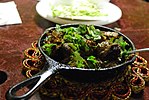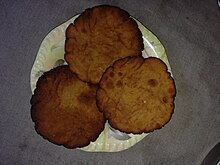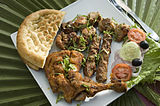Sindhi cuisine
This article needs additional citations for verification. (December 2014) |
| This article is part of the series on |
| Indian cuisine |
|---|
 |
 |
| This article is part of the series |
| Pakistani cuisine پاکستانی پکوان |
|---|
Sindhi cuisine (Sindhi: سنڌي کاڌا) refers to the distinct native cuisine of the Sindhi people from Sindh, Pakistan. Sindhi cuisine has been influenced by Central Asian, Iranian, Mughal food traditions.[1] It is mostly a non-vegetarian cuisine,[2] with even Sindhi Hindus widely accepting of meat consumption.[3] The daily food in most Sindhi households consists of wheat-based flat-bread (Mani) or rice accompanied by two dishes, one gravy and one dry with curd, papad or pickle. Freshwater fish and a wide variety of vegetables are usually used in Sindhi cuisine.[4] Restaurants specializing in Sindhi cuisine are rare, although it is found at truck stops in rural areas of Sindh province, and in a few restaurants in urban Sindh.[5]
Historical influences
[edit]The arrival of Islam within the Indian Subcontinent influenced the local cuisine to a great degree. As Muslims are forbidden to eat pork or consume alcohol and the Halal dietary guidelines are strictly observed, Muslim Sindhis focus on ingredients such as beef, lamb, chicken, fish, vegetables and traditional fruit and dairy. Hindu Sindhi cuisine is almost identical with the difference that beef is omitted. The influence of Central Asian, South Asian and Middle Eastern cuisine in Sindhi food is ubiquitous. Sindhi cuisine was also found in India, where many Sindhi Hindus migrated following the Partition of India in 1947. Before Independence, the State of Sindh was under Bombay Presidency.



Food for special occasions
[edit]Certain dishes are served on special occasions such as Diwali. A Bahji (vegetable dish) called Chiti-Kuni is made with seven vegetables. Special dishes are also served on recovery from serious illness for example when someone makes a full recovery from Chicken Pox, it is common to make an offering and make "mitho lolo", a sweet griddle-roasted flatbread: the dough is wheat flour mixed with oil (or ghee) and sugar syrup flavored with ground cardamom.[6]
- Sai Bhaji ain Chawar: Sai bhaji a popular dish from Sindh consists of white steamed rice served with spinach curry which is given a 'tarka' with tomatoes, onions and garlic.
- Daal Pakwan: (mostly consumed by Sindhi Hindus).
- Koki: is another popular Sindhi flat-bread that is prepared with wheat flour and goes well with any dal, sabzi or even curd or chai.[7]
- Sayun (Vermicelli): typically served as a sweetened (sometimes milk-based) dessert, is popular: Hindu Sindhis serve it on many special occasions such as Thadri and Cheti Chand. Muslim Sindhis serve it on Bakra-Eid and Eid ul-Fitr. On special religious occasions, mitho lolo, accompanied with milk, is given to the poor.

- Sindhi Kadi: is a unique and special dish prepared on festive occasions specially by Sindhis residing in India. It consists of a thick spicy gravy made from chick pea flour unlike buttermilk usually used for kadi preparation along with seasonal vegetables. It is served hot with rice.
- Mitho Lolo: is also served with chilled buttermilk called Matho on various occasions.
- Kheer Kharkoon: A special sweet dish called 'Kheer Kharkun' are prepared and served on Eid ul-Fitr, it is prepared by mixing dates and milk, and slowly simmering the mixture for few hours. The dish is eaten hot in winters and cold in summers.
- Khorak/Churo: a healthy snack made for bride and bridegroom before marriage, it is made of dry fruits and desi ghee, it is given to bride and bridegroom for seven days.[8]
Main dishes
[edit]- Sindhi Biryani: is a special meat and rice biryani, the most popular dish in Sindh and Pakistan.
Sindhi Biryani. - Sindhi Cuisine : A collage of Sindhi food from various areas of Sindh & by different native communities of Sindh.

Sindhi Food - Sindhi Pulhao Bhat: It is Sindhi style Pilaf, it made in mutton, beef, chicken or only in potatoes or chana/chhola, it is less heavy with masalas than Sindhi Biryani.
- Taryal Patata: also called Took Aloo, a staple of Sindhi diet, is a form of thinly sliced, pan fried or deep fried potatoes with local spices. They are consumed in most rural households typically at dinner but can be consumed even for breakfast and lunch alongside other meals. One popular Sindhi way of having "patatas" is to eat it with plain white rice with daal to accompany it.

- Pallo Machi: is a popular Sindhi delicacy, is Hilsha fish prepared with numerous cooking methods. It can be deep fried and garnished with local spices, can be cooked with onions and potatoes into a traditional fish meal or barbequed. The fish often has roe, which is called "aani" in Sindhi and is enjoyed as a delicacy. Often fried alongside the palla and served with the fish fillets.[5][9]
- Palli: is a saag or leafy green from the Chickpeas, and is enjoyed either cooked by itself like spinach or with fish cooked in the palli and called "Machi Palli". The saag has a unique flavor and is quite different from spinach or mustard saag and has a slightly sour and salty taste to it. It can take getting used to for the uninitiated.



- Bheeh Bhajji: ('lotus root' in English). A high quality lotus root is grown in the north of Sindh which is then cooked in clay-pot using various spices, which then results in an excellent delicacy that is famous all over Pakistan.
- Sindhi Curry:
- Sabu Dal Chawar: (yellow daal with rice).
- Sai Bhaji: Vegetarian curry which is mostly
- made with dal (lentil) and Spi.ach
Meat
[edit]most of Pakistani Sindhis are Muslims, they consume different animals, birds and fish meat which are Halal. Common meat like chicken, beef, mutton is quite famous among Pakistani muslim Sindhis, in addition camel, rabbit, many birds like Aari (Fulica atra), Kunj (Demoiselle crane), Titar (Grey francolin), Jhirkri (Sparrow), Duck meat is also consumed.[10] many seafood like fishes, prawns etc are also eaten. The fish Sajji of Sanghar is quite famous in all over Pakistan.[11]
Drinks
[edit]
- Thadal: is a cooling and energizing drink, used by the pehlwan (wrestlers), prepared using ground char magaz, dry fruits, pepper, almonds and poppy seeds - khashkhaash).[12]
- Sharbat: drink made from rose petals or sandal wood.
- Falooda: vermicelli and ice on top of an Ice cream.
- Lassi: Dahi (yogurt)-based traditional drink.
Desserts
[edit]- Khirni: hot sweet pudding made with milk and crushed rice into paste, flavours of cardamoms, dry fruits and saffron.
- Busri: a special Sindhi sweet bread made of two breads, filled with powder of jaggery called musti/mithai sometimes with sugar, and a chunk of desi ghee or Makhan (butter) on top, eaten mostly in winters, also offered to bride and bridegroom on wedding day.[13]
- Ugham Halwo: is a traditional halwa made in Dadu district, made with almonds, pistachios, cashew nuts and important (ugham seeds) are used in desi ghee, it is very healthy and best in winters.[14]
- Sindhi Halwo: made with corn flour, water, ghee and dry fruits, it has jelly like texture.[15][16]
- Mao: is a sweet dish made out of milk and sugar, milk is cooked until it becomes thick paste, then it is served with dry fruits and nuts.[17] Mehar city is famous for making Sindhi mao.
- Tairee Bhat: the sweet rice made in jaggery with kishmish (Raisins) and coconut.
- Borindo: round balls like sweet snack made of sugar syrup/honey/jaggery and sesame seeds or other dry fruits and nuts.
- Lai: same as like borindas but flat and Lais are made of different dry fruits, sesame seeds etc.
- Kutti: Mashed Ofrato (Paratha Bread) with sugar, butter and crushed dry fruits.[18][19]
- Lolo or Mitho Lolo: Sweeter version of koki - also made if you get chicken pox.

Sindhi Halwo (Corn flour halwa) - Chulho: is a sweet bread of rice flour or wheat flour with sugar sprinkled on top, with desi ghee or makhan.
- Gheeyar: a Jalebi like Sindhi sweet but large in size, eaten on festivals.[20]
- Ghotki ja Pera: are usually cone shaped sweetmeat made in ghotki city.
Other Sindhi desserts and sweets like Sero, Paihu, Rabri, Atay ju Saiyun, Bondi Singhar, Daro, Kariyio tikio etc.[21][22][23]
Snacks
[edit]- Pappad: the favorite snack of Sindhis pappad is a thin flat bread like snack, made of urad dal, moong dal with pepper, jeera, eaten with meal, or at evening with tea.[24][1]
- Khicha: is like pappad but made with rice flour and is less spicy, eaten with Chutney.[25]
- Pakora: are fritters, can be made with sliced potatoes called Patatai or with onions, pea and green chili pakoras called Sanna/Sanai pakora, Green chili pakoras called Mirchai pakora, chicken pakora, beef pakoras, Bheeh (lotus root) pakoras etc.[26]
- Buri/Boorani: is unique snack of yellow powder or pollen of flower that grows in lakes and ponds.[27]
- Pabura/Pabur: the seeds of Lotus flower.[28]
- Phariyun: is a winter snack, a green pods boiled in water and sprinkled with ambchoor, black salt and red chili powder.[29]
- Gajar: boiled sweet potatoes, sprinkled with salt, black, red chili powder and ambchoor.
- Baisan ju Tikyun: flatbread like snack made of Chickpea flour with coriander, onions, salt, pepper.[30]
Translations
[edit]This section provides the translations between Urdu/Hindi, Sindhi and English (British and American) cooking terms of common Sindhi food.
There are occasional differences in Sindhi dialects for instance Hyderabadi Sindhi will refer to an egg as 'bedo' however Sindhis from other parts will refer to it as 'aano'.
Herbs
| Urdu/Hindi | Sindhi | English |
|---|---|---|
| Sokha Dhan-ia | Sukka Dhaanna (سڪاڌاڻا) | Coriander Seed |
| Hara Dhan-ia | Sawa Dhaanna | Coriander Leaves |
| Podeena | Phodno | Mint leaves |
| Methi | Hurbo | Fenugreek |
| Taez paat | Kamaal Pat | Bay leaf |
| Kadhi pata | Kari patto | Curry Leaves |
Spices
| Urdu/Hindi | Sindhi | English |
|---|---|---|
| Amchoor | Amba-choor | dry mango powder |
| Elaichi | Photo (ڦوٽا) | Cardamon Pods |
| Badi elaichi | Wado photo | Black Cardamon |
| Namak | Loonn/Noonn (لوڻ) | Salt |
| Kali mirch | Kaara Mirch | Black Pepper |
| Lah-sun | Thoom (ٿوم) | Garlic |
| Adrak | Adrak (ادرڪ) | Ginger |
| Zeera | Jiro (جيرو) | Cummin Seeds |
| Haldi | Haidda (هيڊ) | Turmeric Powder |
| Heeng | Hing/Vagaranee | Asafoetida |
| Zafran | Zafran/Kaisar(ڪيسر) | Saffron |
| Gur | Gud (ڳڙ) | Jaggery |
| Mirch | Mirch (مرچ) | chillies |
| Imli | Gida-mi-ri (گدامڙي) | Tamarind |
| Khaskhas (کسکس) | Khashkhash | poppy seeds |
| Pulao Jeeri | Caraway | |
| Raee | Rai | mustard seeds |
| Long | Lua-nga (لونگ) | Clove |
| Til | Tirr | Sesame Seed |
| Garam Masala | Garam masalo | . |
| Dalchini | Mithi Kathi/Darchini | Cinnamon |
| Sauf | Sonf | Aniseed |
| Methi dana | Hurbo | Fenugreek seeds |
| Lal mirch | Gharo mirch | Red Chilli |
Fruit, Vegetable and Pulses
| Urdu/Hindi | Sindhi | English |
|---|---|---|
| Baingan | Vaangann واڱڻ | Aubergine (UK) or Eggplant (US). |
| Band Gobi | Band/Pata Gobi | Cabbage |
| Gaajar | Gajjar (گجر) | Carrot |
| Daal | Daal | Lentil |
| Sag | Saagg | Mustard Greens (Vegetable) |
| Khajoor | Qatal or Khaarak (کارڪ يا ڪتل) | Dates |
Nuts
| Urdu/Hindi | Sindhi | English |
|---|---|---|
| Moongphali | Behi-munga or Munghera (مڱيرا) Kha-ja | Peanuts |
| Kaju | Khaaja | Cashewnuts |
| Badaam | Badaamyoon (باداميون) | Almond |
| Pista | Pista/Dodiyun | Pistachio |
| Akhrot | Akhrot | Walnut |
Other
| Urdu /Hindi | Sindhi | English |
|---|---|---|
| Ghee | Gheehu/Ghay | Clarified Butter |
| Chapati/
Roti |
Maani/Phulko/Daggri/
Daggar (ڦلڪو) |
Thin wrap |
| Cheeni or Shakkar | Khand(کنڊ), Khandre | Sugar |
| Bheja or Maghaz | Maghz (مغز), Mejalo | Brain |
| Papar | Pa-pper(پاپڙ) | Poppodum |
| Double-roti | Dab-roti/Dhabbal | Bread |
| Aata | Atto(اٽو) | Wholewheat flour (Chappati flour) |
| Anda | Bedo (Hyderbadi Sindhi) or Ando, Ano(آنو) | Egg |
| Murghi | Kukkar (ڪڪڙ) | Chicken |
| Paplate | Paplet پاپليٽ | Pomfret fish |
| Chhota Gosht | Nandho Gosht | Mutton |
| Barra Gosht | Wado Gosht | Beef |
| Palla machhli | Pallo(پلو) | shad/Hilsa (fish) |
Vegetarian cuisine
[edit]This section needs expansion. You can help by adding to it. (June 2010) |
Certain sects of the Sindhi community are vegetarians. The Thathai, Halai and Kutchi Bhatias are followers of Vallabh Acharya, who put forward a way to worship Sri Krishna called Pushtimarg. They are strict vegetarians who do not eat even onions and garlic and are devoted to Srinathji, the child form of Sri Krishna.[31]
Sindhi Pickles
[edit]Sindhi achar is made of different vegetables and fruits like: Carrot pickle, Mango pickle, Mix fruit pickle, turnip pickle, Green chilli pickle etc,[24] Shikarpur is famous for Sindhi achar.[32][33]
Gallery
[edit]


















See also
[edit]References
[edit]- ^ a b Reejhsinghani, Aroona (2004). Essential Sindhi Cookbook. Penguin Books India. ISBN 978-0-14-303201-4.
- ^ Reejhsinghani, Aroona (2004). Essential Sindhi Cookbook. Penguin Books India. ISBN 978-0-14-303201-4.
- ^ Kent, Eliza F.; Kassam, Tazim R. (2013-07-12). Lines in Water: Religious Boundaries in South Asia. Syracuse University Press. ISBN 978-0-8156-5225-0.
- ^ Reejhsinghani, Aroona (2004-08-04). The Essential Sindhi Cookbook. Penguin UK. ISBN 978-93-5118-094-4.
- ^ a b Jillani, Maryam (2019-04-02). "Sindhi food: A vibrant cuisine hidden from the Pakistani and Indian public". DAWN.COM. Retrieved 2021-07-20.
- ^ "Various Sindhi recipes". www.simplysindhirecipes.com. WordPress. Retrieved 3 September 2015.
- ^ "Koki". 31 May 2008.
- ^ Keswani, Alka (2021-04-29). "Khhoraak, the winter special Sindhi sweet". Sindhi Rasoi |Sindhi Recipes. Retrieved 2024-01-30.
- ^ Khan, M. Hussain (2015-09-03). "The palla, the shrine, the catch and the cook". DAWN.COM. Retrieved 2024-01-30.
- ^ WNN (2020-02-21). "Common Coot: A disappearing migratory bird in Sindh". World Nature News. Retrieved 2024-02-03.
- ^ "Small-town Pakistani chef known for innovative fish recipe eyes Middle East". Arab News PK. 2021-01-09. Retrieved 2024-02-03.
- ^ Sindhi Drinks https://pandareviewz.com/sindhi-food-cuisine/
- ^ "Busri😍sindhi dish Recipe by Rooha Abdullah". Cookpad. 2019-03-28. Retrieved 2024-01-30.
- ^ ڈیسک, ویب (2021-12-22). "سندھ کی سوغات "اگم حلوہ" فوائد جان کر آپ حیران رہ جائیں گے -". ARYNews.tv | Urdu - Har Lamha Bakhabar (in Urdu). Retrieved 2024-01-30.
- ^ "Karachi Halwa Recipe - Bombay halwa Recipe". Indian Vegetarian Recipes in Hindi | NishaMadhulika.com (in Hindi). 2012-08-31. Retrieved 2024-01-30.
- ^ Lala, Lata (2018-06-06). "Karachi Halwa | Bombay Halwa - Yummy Tales Of Tummy". Retrieved 2024-01-30.
- ^ "Moosani mava: spoiled milk turned into sweet delight". Daily Times. 2022-02-28. Retrieved 2024-01-30.
- ^ Keswani, Alka (2008-03-16). "Bhori(Kuttti)". Sindhi Rasoi |Sindhi Recipes. Retrieved 2024-01-30.
- ^ Jillani, Maryam (2019-04-02). "Sindhi food: A vibrant cuisine hidden from the Pakistani and Indian public". DAWN.COM. Retrieved 2024-01-30.
- ^ Keswani, Alka (2014-04-06). "Gheeyar Sindhi Jalebi". Sindhi Rasoi |Sindhi Recipes. Retrieved 2024-01-30.
- ^ Keswani, Alka. "Dessert Archives". Sindhi Rasoi |Sindhi Recipes. Retrieved 2024-01-30.
- ^ Naqsh e Zehra. "Sindhi sweets". Youlin Mazgine.
- ^ "Sindhi Desserts". Ribbons to Pastas. May 2016.
- ^ a b Shyam, Radhika D. (2021-08-14). "Papads, pickles and Partition: A Sindhi reminiscence". The Hindu. ISSN 0971-751X. Retrieved 2024-02-03.
- ^ Mulchandani, Anil (2017-09-09). "Flavours from a Sindhi kitchen". The New Indian Express. Retrieved 2024-02-04.
- ^ Keswani, Alka (2008-05-03). "Sanna pakora". Sindhi Rasoi |Sindhi Recipes. Retrieved 2024-02-04.
- ^ Keswani, Alka (2017-05-21). "Bhuri~Bhurrani Mitti". Sindhi Rasoi |Sindhi Recipes. Retrieved 2024-02-04.
- ^ Sherrif, Ahmed (2018-08-09). "Makhana, Nadru & More: Why India's National Flower Is Great For Your Health!". The Better India. Retrieved 2024-02-04.
- ^ Keswani, Alka (2022-02-01). "Dadhri|Forgotten Sindhi Snack". Sindhi Rasoi |Sindhi Recipes. Retrieved 2024-02-04.
- ^ Keswani, Alka (2009-04-13). "Sindhi style gattey ki subzi". Sindhi Rasoi |Sindhi Recipes. Retrieved 2024-02-04.
- ^ "panjakhada.com". Retrieved 21 December 2014.
- ^ "شکار پور کا اچار". jang.com.pk. Retrieved 2024-02-03.
- ^ "Lok Mela: Day two showcases colours of Sindh". The Express Tribune. 2014-04-12. Retrieved 2024-02-03.




